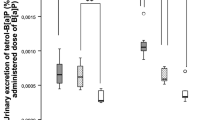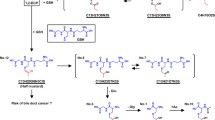Abstract
In order to clarify the etiology of a dose-related increase in the incidence of tubular cell adenocarcinomas of the kidney in male rats, the nephrotoxicity of p-dichlorobenzene (p-DCB) was investigated in a subchronic study. Groups of ten male and ten female Fischer 344 rats were dosed by gavage with 0 (controls), 75, 150, 300 or 600 mg p-DCB/kg/day in corn oil. Half of the animals were sacrificed after 4 weeks and the remainder after 13 weeks. Increased urinary LDH and epithelial cell excretion and exacerbation of hyaline droplet accumulation in the cytoplasm of renal cortical cells were observed in male rats over the entire dose range investigated. Tubular single cell necrosis, dilated tubules with granular cast formation in the outer zone of the medulla, were evident in male rats after 4 and 13 weeks of treatment with doses of 150–600 mg/kg/day. In female rats there was no indication of a nephrotoxic action of p-DCB. The effects on the kidney, both in their morphological characteristics and the fact that they occur exclusively in male animals, correspond to the light hydrocarbon nephropathy observed as a result of short-term treatment with a number of aliphatic and cyclic hydrocarbons. The development of cortical renal tumors seems to be associated with this kind of kidney damage which is unique to male rats. The literature on this subject generally regards these renal effects as not predictive for man.
Similar content being viewed by others
References
Alden CL (1986) A review of unique male rat hydrocarbon nephropathy. Toxicol Pathol 14: 109–111
Alden CL, Kanerva RL, Ridder G, Stone LC (1984) The pathogenesis of the nephrotoxicity of volatile hydrocarbons in the male rat. In: Mehlmann MA, et al. (eds) Renal effects of petroleum hydrocarbons. Princeton Scientific Publ., Princeton NJ., pp 107–120
Alden CL, Ridder G, Stone L, Kanerva RL (1985) Pathology of petrochemical fuels in male rats. Acute toxicity. In: Bach PH, Lock EA (eds) Renal heterogeneity and target cell toxicity. John Wiley & Sons, Chichester, New York, Brisbane, Toronto, Singapore, pp 461–472
Connor ThH, Thess JC, Hanna HA, Monteith DK, Matney TS (1985) Genotoxicity of organic chemicals frequently found in the air of mobile homes. Toxicol Lett 25: 33–40
Fabiny D, Ertingshausen G (1971) Automated reaction-rate method for determination of serum creatinine with the centrifichem. Clin Chem 17: 696–700
Gutmann I, Bergmeyer HU (1974) In: Bergmeyer HU (ed) Methoden der enzymatischen Analyse, 3. Edn, vol II. Verlag Chemie, Weinheim, p 1842
Haworth S, Lawlor T, Mortelmann K, Speck W, Zeiger E (1983) A paradoxical effect of aeration on the accumulation of root tip metaphase cells by spindel inhibitors. Exp Cell Res 17: 262–272
Kluge F, Gerb AC, Boss N, Fahlbusch R, Scriba PC (1970) Eine verbesserte fluorimetrische Cortisolbestimmung im Serum: Diagnostische Bedeutung und therapeutische Folgerungen für die NNR-Insuffizienz. Klin Wochenschr 48: 929–934
Lawlor T, Haworth SR (1979) Evaluation of the genetic activity of nine chlorinated phenols, seven chlorinated benzenes, and three chlorinated hexanes. Environ Mutagen 1: 143
Lock EA, Charbonneau M, Strasser J, Hazlehurst S, Swenberg J (1987) Light hydrocarbon-induced nephrotoxicity: the interaction of 2,2,4-trimethylpentane with α2μ-globulin in the male rat kidney. 3rd International Symposium on Nephrotoxicity, Guildford, August 3–7, 1987, Abstract Volume
Loeser E, Litchfield MH (1983) Review of recent toxicology studies on p-dichlorobenzene. Food Chem Toxicol 21: 825–832
Maruhn D (1976) Rapid colorimetric assay of β-galactosidase and N-acetyl-β-glucosaminidase in human urine. Clin Chim Acta 73: 453–461
Maruhn D (1979) Preparation of urine for enzyme determination by gel filtration. Curr Probl Clin Biochem 9: 22–29
MacFarland HN (1984) Xenobiotic induced kidney lesions: hydrocarbons. The 90-day and 2-year gasoline studies. In: Mehlmann MA et al. (eds) Renal effects of petroleum hydrocarbons. Princeton Scientific Publ., Princeton NJ, pp 51–56
Mondorf AW, Breier J, Hendus J, Scherberich JE, Mackenrodt G, Shah PM, Stille W, Schoeppe W (1978) Effect of aminoglycosides on proximal tubular membranes of the human kidney. Eur J Clin Pharmacol 13: 133–142
Myhr BC (1973) A screen of pesticide toxicity to protein and RNA synthesis in HeLa cells. J Agric Food Chem 21: 363–367
National Toxicology Programme (1987) Technical Series No. 319. Toxicology and carcinogenesis studies of 1,4-dichlorobenzene (CAS No. 106-46-7) in F344/N rats and B6C3F1 Mice (gavage studies). NIH Publications No. 87-2575
Perocco F, Bolognesi S, Alberghini W (1983) Toxic activity of seventeen industrial solvents and halogenated compounds on human lymphocytes cultured in vitro. Toxicol Lett 16: 69–75
Phillips RD, Cockrell BY (1984) Effect of certain light hydrocarbons on kidney function and structure in male rats. In: Mehlmann MA, et al., Renal effects of petroleum hydrocarbons. Princeton Scientific Publ., Princeton NJ, pp 89–105
Rapson HW, Nazar MA, Butsky VV (1980) Mutagenicity produced by aqueous chlorination of organic compounds. Bull Environ Contam Toxicol 24: 590–596
Recommendations of the German Society of Clinical Chemistry (Empfehlungen der Deutschen Gesellschaft für Klinische Chemie) (1972) Z klin Chem klin Biochem 10: 182–192
Richterich R (1968) Klinische Chemie, 2. Edn. Akadem. Verlagsgesellschaft, Frankfurt
Shimizu M, Yasui Y, Matsumoto N (1983) Structural specificity of aromatic compounds with special reference to mutagenic activity in Salmonella typhimurium — a series of chloro- or fluoro-nitrobenzene derivatives. Mutat Res 116: 217–238
Short BG, Burnett VL, Swenberg JA (1986) Histopathology and cell proliferation induced by 2,2,4-trimethylpentane in the male rat kidney. Toxicol Pathol 14: 194–203
Wilcoxon F (1947) Probability tables for individual comparisons by ranking methods. Biometrics 3: 119–122
Author information
Authors and Affiliations
Rights and permissions
About this article
Cite this article
Bomhard, E., Luckhaus, G., Voigt, W.H. et al. Induction of light hydrocarbon nephropathy by p-dichlorobenzene. Arch Toxicol 61, 433–439 (1988). https://doi.org/10.1007/BF00293688
Received:
Accepted:
Issue Date:
DOI: https://doi.org/10.1007/BF00293688




